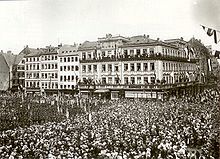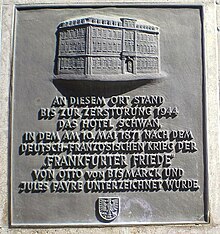Peace of Frankfurt
The Peace of Frankfurt concluded between the French Republic and the German Reich was signed on May 10, 1871 in Frankfurt am Main and formally ended the Franco-German War . In fact confirmed and supplemented the Frankfurt Peace to in February 26 Versailles closed preliminary peace of Versailles .
content
The Frankfurt Peace Treaty comprises 18 articles and three additional articles (see web links). The treaty ratified on May 16 and 18, 1871 also includes a protocol dated May 15, 1871, which records the accession of the southern German states of Baden , Bavaria and Württemberg to the peace treaty. These states had entered the war between France and Prussia due to a military alliance between them and the Prussian- dominated North German Confederation and then joined the German Reich during the war, into which the North German Confederation was absorbed during the war.
The definitive treaty mainly corrected the demarcation line laid down in the preliminary peace of Versailles (Article 1, Additional Article 3).
Article 2 allowed the residents of the ceded territories to move to France.
Article 7 contained the modalities of the obligation of France to pay reparations already laid down in the preliminary peace . The sum was set at five billion gold francs (1,450 tons of fine gold ), payable within three years. A ratio of 1 Prussian thaler to 3.75 francs was used as the exchange rate. Correspondingly, the debt total was equivalent to around 1.33 billion Prussian thalers. The departments of Oise , Seine-et-Oise , Seine-et-Marne and Seine as well as the fortifications of Paris were to remain occupied by German troops until the reparations were paid.
The remaining articles and additional articles 1 to 2 contain provisions on, among other things, prisoners of war, trade agreements and the railways in the areas to be ceded.
consequences
The peace treaty confirmed France's renunciation of the predominantly German-speaking larger areas of Alsace and Lorraine . Shortly afterwards they became part of the German Empire founded during the war as the Reichsland Alsace-Lorraine . Belfort, which was part of the otherwise ceded department of Haut-Rhin at that time, was mostly French-speaking and remained with its surroundings as Territoire de Belfort in France. The ceded areas were placed under the authority of the emperor by Article 3 of the "Law on the unification of Alsace and Lorraine with the German Empire" passed in June 1871 (the designation "Reichsland Alsace-Lorraine" is not found in this law).
A number of places from Alsace and Lorraine were returned to France. Areas in eastern France remained under German occupation until the reparations were paid . Some parts of French Lorraine came to Germany through the exchange of territory. France managed to pay the reparations faster than planned. Some of the cash payments were stored as Reich war treasure in the " Juliusturm " of the Spandau Citadel . After the last installment had been paid, the last German troops left French territory on September 16, 1873.
The reunification of Alsace-Lorraine with Germany and the high reparation sums put a heavy burden on the Franco-German relationship. The recovery (revenge) of the ceded areas was a leitmotif of French politics up to the First World War . Some sections of the French and German upper classes and also the other sections of the population viewed each other as "archenemies" and emphasized the Franco-German hereditary enmity .
miscellaneous
The place of signing was the Hotel zum Schwan in Steinweg , where the Hugendubel bookshop now stands. Authorized negotiators for the German Reich were Prince von Bismarck and Count von Arnim , for the French Republic Jules Favre , Augustin Pouyer-Quertier and Marc-Eugène de Goulard . After the annexation of Frankfurt in 1866 by Prussia , the relationship between the city and the kingdom was very tense. Bismarck tried to use the Peace of Frankfurt positively for this relationship as well. After the peace agreement he said: I sincerely wish that the Peace of Frankfurt will also bring peace for Frankfurt and peace with Frankfurt.
literature
- Complete geographical-topographical-statistical local lexicon of Alsace-Lorraine. Contains: the cities, towns, villages, castles, municipalities, hamlets, mines and smelting works, farms, mills, ruins, mineral springs, etc. with details of the geographical location, factory, industrial and other commercial activities, the post, railroad and telegraph stations and historical notes etc. Adapted from official sources by H. Rudolph. Louis Zander, Leipzig 1872 ( e-copy ).
- Henning Roet de Rouet: Frankfurt am Main as a Prussian garrison. From 1866 to 1914. Societäts Verlag, Frankfurt am Main 2016, ISBN 978-3-95542-227-1
Web links
Individual evidence
- ↑ For comparison: The total was 8 times the Prussian state budget for 1869, with 173.7 million thalers income and 167.5 million thalers expenditure. In: General account on the state budget: for d. Financial year .... 1869 , Königlich Preußische Staatsdruckerei, Berlin 1871, S.VI
- ^ Peace at Frankfurt (May 10, 1871), text of the treaty (French / German), on Wikisource
- ↑ According to one, to the Ministry directed Memorandum of Otto von Bismarck , the German leadership France wanted the highest possible ( Contribution ) impose. Quote from Otto von Bismarck: "It will be our task to strive for the largest possible contribution that is sufficient for all purposes ", according to Fritz Stern: Gold und Eisen - Bismarck and his banker Bleichröder . Beck, Munich 2011, p. 223.
- ^ Directory of the places in Alsace and Lorraine, which were returned to France as a result of the Frankfurt Peace Treaty of May 20, 1871 . In: Complete geographical-topographical-statistical local lexicon of Alsace-Lorraine. Contains: the cities, towns, villages, castles, municipalities, hamlets, mines and smelting works, farms, mills, ruins, mineral springs, etc. with details of the geographical location, factory, industrial and other commercial activities, the post, railroad and telegraph stations and historical notes etc. Adapted from official sources by H. Rudolph. Louis Zander, Leipzig 1872, Sp. 71–78 ( online .)
- ^ Directory of the places in French Lorraine, which came to Germany through the exchange of territory as a result of the Frankfurt Peace Treaty, but are already listed in the first section , ibid, Col. 77-78 below ( online ).
- ^ Henning Roet de Rouet: Frankfurt am Main as a Prussian garrison. From 1866 to 1914. Societäts Verlag, Frankfurt am Main 2016, ISBN 978-3-95542-227-1 , p. 107.



